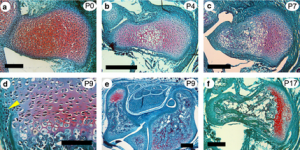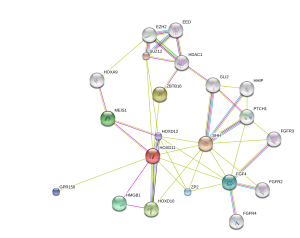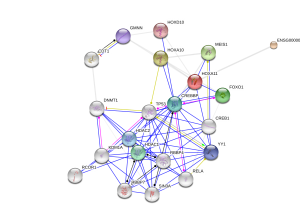This study supports that altering gene expression of Hoxa11 and Hoxd11 may be a way to grow taller as those genes can turn short bones into long bones. Unfortunately, the genes that are known to interact with these genes are small in number and not known to be manipulatible by exercise or nutrition. So it is more likely that in the future the Hoxa11 and Hoxd11 genes may contribute to height growth by manipulating the expression of these genes via an adenovirus.
The pisiform growth plate is lost in humans and supports a role for Hox in growth plate formation.
“The human pisiform is a small, nodular, although functionally significant, bone of the wrist. In most other mammals, including apes and Australopithecus afarensis, pisiforms are elongate. the typical mammalian pisiform forms from two ossification centers. We hypothesize that: (i) the presence of a secondary ossification center in mammalian pisiforms indicates the existence of a growth plate; and (ii) human pisiform reduction results from growth plate loss. We surveyed African ape pisiform ossification and confirmed the presence of a late-forming secondary ossification center in chimpanzees and gorillas. Identification of the initial ossification center occurs substantially earlier in apes relative to humans, raising questions concerning the homology of the human pisiform and the two mammalian ossification centers. Second, we conducted histological and immunohistochemical analyses of pisiform ossification in mice. We confirm the presence of two ossification centers separated by organized columnar and hypertrophic chondrocyte zones. Flattened chondrocytes were highly mitotic, indicating the presence of a growth plate. Hox genes have been proposed to play a fundamental role in growth plate patterning. The existence of a pisiform growth plate presents an interesting test case for the association between Hox expression and growth plate formation, and could explain the severe effects on the pisiform observed in Hoxa11 and Hoxd11 knockout mice. Hoxd11 is expressed adjacent to the pisiform in late-stage embryonic mouse limbs supporting a role for Hox genes in growth plate specification.”
“Compared with humans, the pisiform of most other mammals, including primates, is substantially enlarged and elongated”
Here’s a good visual of growth plate formation:
“a) At birth (P0) the pisiform largely consists of undifferentiated hyaline cartilage. Note the future articular surfaces adjacent to the triquetral (right) and the transitional region near the insertion of the FCU (left). Each of these is distinct from the fibrous periosteal layers that surround the future pisiform shaft. (b) At P4 the cartilage has undergone differentiation to flattened columnar and hypertrophic chondrocytes. It is the calcified hypertrophic matrix that is staining red in Fig. 3(a). (c) By P7 the primary center of ossification begins to be replaced by bone. A broad region of flattened columnar and hypertrophic chondrocytes is preserved at the palmar end (right). (d) At P9 the preserved strip of cartilage displays all of the hallmarks of a growth plate: organized columnar and hypertrophic zones and a perichondrial ring (yellow arrowhead) adjacent to the bone collar. (e) A transverse section through the carpal tunnel demonstrates the unique ossification of the pisiform (left). Note the preserved region of red stained cartilage at the palmar end. In contrast the scapholunate (right) has ossified as a single primary center extending into the projecting tubercle. (f) At P17 the growth plate appears to be losing its activity, as there is no longer an identifiable hypertrophic zone underlying the columnar chondrocytes.”<-so if via LSJL we can induce regions of hyaline cartilage they could potentially become growth plates.
“Full deletion of Hoxa11 or Hoxd11 results in a highly penetrant phenotype with shortened pisiforms that often fuse to the triquetral (ulnare) or less commonly to the scapholunate and triquetral ”
” ‘no Hoxd land’ for short bone morphology”<-Maybe we could upregulate Hoxd in short bones to make them become long bones?
“In short bones and epiphyses, the initial process of chondrocyte differentiation is similar. However, expanded cartilaginous growth plates or active perichondrial rings do not form. Instead, the periphery of these regions largely consists of a narrow three to four cell layer of round chondrocytes that anticipate the future articular zone. In each of these respects (organized chondrocyte zones, active perichondrial ring and deposition of the bone collar), the pisiform is more similar to long bones”<-The organized chondrocyte zones, active perichondrial ring and deposition of the bone collar could be related to Hoxd.
“mice with reduced Hoxa11/Hoxd11 expression display decreased proliferation within mesenchymal condensations and dramatic shortening of the radius and ulna such that they also resemble short bones”
If we can induce Hoxd11 expression in short bones we can make those bones longer and thus ourselves taller.
Looking at the String Embl gene interaction reveals a problem in that very few genes directly interact with Hoxd11. Although LSJL upregulates the related gene Hoxd10:
Similarly with Hoxa11:



Please stop with all the LSJL, or give me one freaking proof LSJL actually works, enough people have tried it out.
I thought this site was serioust untill reading all the LSJL info.
I found a better way to do the x-ray analysis which will be up in a day or two.
Lsjl works on my fingers and forearm too.Legs , different story.Tried every method from angular to just regular lsjl on ankles, knees and between joints with no sucess.Only thing that work is kicking and cycling.I grew 1inch in 6 months back in 2012 ,when I was 36.Then tried lsjl with no result.Now back on kicking and cycling for 3 months now and grew another 1/4 inch.You all can download “How to Naturally Increase Your Height 2-3 Inches WIthin 7 Weeks” in free stuff section.I am only doing kicking and cycling due to my busy schedule.Only takes about 30 minutes altogether.Results are slow but permanent and endless lost some weight too.
Do you have any evidence that LSJL worked on your fingers and forearm? And do you have any evidence that kicking and cycling increased your height? It would be insteresting if it did as I can’t think of a mechanical reason why kicking and cycling would increase height. Maybe you could get a physical and when the nurse records your height. Get the records with earlier height and publish the records online.
Sean Luger:
When did you measure your height? Always at the same time of the day?
You 100% sure you gained height? You know your height is about 1 inch more in the morning compared to night.
Did you use bike with high seat, or just regular bike?
I’m really holding my breath on the potential increase in arm lenght. My arms are already short and I’m afraid any increase in height will make that more noticeable.
Why do you care about arm lengthening?
First of all you need to find a way to grow your height, and I guess you dont know how to do that. ’cause the only way nowadays is to do leg lengthening.
I do because it’s important in boxing
Sean Luger: You measure in the same time at the day. cause morning hight is around 1 inch taller than night hight so maybe you dident gain nothing from bike. ?
Don’t know if this has already been seen or if you’d want to report on it but I think it’s a nice find:
http://www.factor-tech.com/health-augmentation/8569-scientists-announce-key-breakthrough-in-the-quest-to-regenerate-bones/
I always measure around afternoon.And yes it’s high seat on the bike.Don’t forget about kicking 300-400 front snapkicks each leg.You can save time by kicking 20 in the row for one leg and switch.It works out to 15 minutes of biking and 10 minutes of kicking.5 days on 2 days off.Recovery is very important.